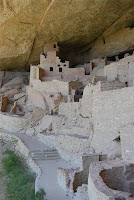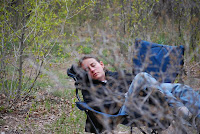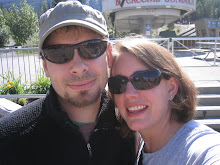














Situated at 7,000 feet above sea level and just outside of Cortez, Colorado is Mesa Verde National Park. This was a totally different landscape than what we’ve been used to seeing during these past 2 months and we were pleasantly surprised at how nice this park was. Up, up, up windy roads from an otherwise, pretty flat surrounding area below.
As we entered the park, the first thing we noticed was burnt trees everywhere. The park had some bad luck the last few years due to drought and lightning and fires actually burned ¾ of the park during a period from 1996 – 2002. I spoke to a ranger that told me it will take close to 100 years for the trees to make their cycle and start to re-grow. The blackened tree skeletons that encompassed much of this mountainous landscape were still worth admiring and photographing, but I’m sure the area looked much different when there wasn’t so much blank space held now by air but was once shaded with juniper, Gambel oak, and pinyon trees.
We stayed in this well equipped, but surprisingly not very busy park for 2 nights and enjoyed what it had to offer. We’d never heard of it before and I think it has as much to offer as Grand Canyon, just on a smaller scale and from more of an archeological point-of-view. The best part was that it was not over populated with tourists. There are over 600 cliff dwelling and 4,500 archeological sites throughout the park, not to mention the wildlife – mule deer, elk and bear (we saw all but a bear).
Matt and I took separate tours (since they didn’t allow dogs on the difficult trails) of these cliff dwellings. Matt did the tour of the Spruce Tree House, which is the best preserved dwelling and I did the Cliff Palace tour which is the largest of the cliff dwellings. Thank goodness they had ladders and man-made stairs for us to get down to them, or not everyone on the tour would have survived as its one heck of a fall if you loose a step. From the pictures we took, they look like doll houses, however I promise you there were cities with 100-150 homes built right into the rock. Granted they were much smaller than the homes we live in today, but the ancestral people were only about 5 foot tall and could fit in little openings and in order to keep warm they kept the doorways and rooms small. Those holes you see that look like windows are actually doorways into these buildings.
I figure it would be pretty cool to live in a cliff dwelling if they were easier to get in to. With 50 feet of cliff above you and 50 feet of cliff below you, it sure wasn’t easy. The Ancestral Puebloans had to physically climb up and down the cliffs to carry food, kids, and rocks into these homes-in-the-cliffs where they lived around 1200 A.D. In some areas, you could still see the holes in the rock where they’d place their hands and feet in order to achieve such a stunt. Quite amazing.
Matt, Bailey & I drove into New Mexico today. We are staying close to Chama in the Heron Lake State Park. We will be here through the weekend and during that time will take a day trip to Taos and then from here head down to Sante Fe for a couple of days. We’ve made it to a state neither of us has yet visited and it’s sort of exciting to be somewhere new and unknown.
As we entered the park, the first thing we noticed was burnt trees everywhere. The park had some bad luck the last few years due to drought and lightning and fires actually burned ¾ of the park during a period from 1996 – 2002. I spoke to a ranger that told me it will take close to 100 years for the trees to make their cycle and start to re-grow. The blackened tree skeletons that encompassed much of this mountainous landscape were still worth admiring and photographing, but I’m sure the area looked much different when there wasn’t so much blank space held now by air but was once shaded with juniper, Gambel oak, and pinyon trees.
We stayed in this well equipped, but surprisingly not very busy park for 2 nights and enjoyed what it had to offer. We’d never heard of it before and I think it has as much to offer as Grand Canyon, just on a smaller scale and from more of an archeological point-of-view. The best part was that it was not over populated with tourists. There are over 600 cliff dwelling and 4,500 archeological sites throughout the park, not to mention the wildlife – mule deer, elk and bear (we saw all but a bear).
Matt and I took separate tours (since they didn’t allow dogs on the difficult trails) of these cliff dwellings. Matt did the tour of the Spruce Tree House, which is the best preserved dwelling and I did the Cliff Palace tour which is the largest of the cliff dwellings. Thank goodness they had ladders and man-made stairs for us to get down to them, or not everyone on the tour would have survived as its one heck of a fall if you loose a step. From the pictures we took, they look like doll houses, however I promise you there were cities with 100-150 homes built right into the rock. Granted they were much smaller than the homes we live in today, but the ancestral people were only about 5 foot tall and could fit in little openings and in order to keep warm they kept the doorways and rooms small. Those holes you see that look like windows are actually doorways into these buildings.
I figure it would be pretty cool to live in a cliff dwelling if they were easier to get in to. With 50 feet of cliff above you and 50 feet of cliff below you, it sure wasn’t easy. The Ancestral Puebloans had to physically climb up and down the cliffs to carry food, kids, and rocks into these homes-in-the-cliffs where they lived around 1200 A.D. In some areas, you could still see the holes in the rock where they’d place their hands and feet in order to achieve such a stunt. Quite amazing.
Matt, Bailey & I drove into New Mexico today. We are staying close to Chama in the Heron Lake State Park. We will be here through the weekend and during that time will take a day trip to Taos and then from here head down to Sante Fe for a couple of days. We’ve made it to a state neither of us has yet visited and it’s sort of exciting to be somewhere new and unknown.


















































